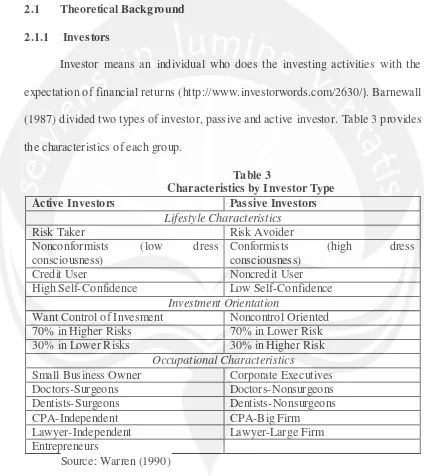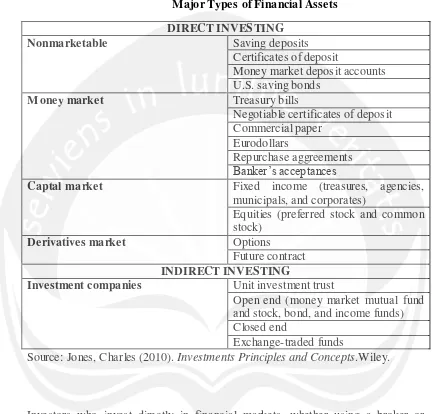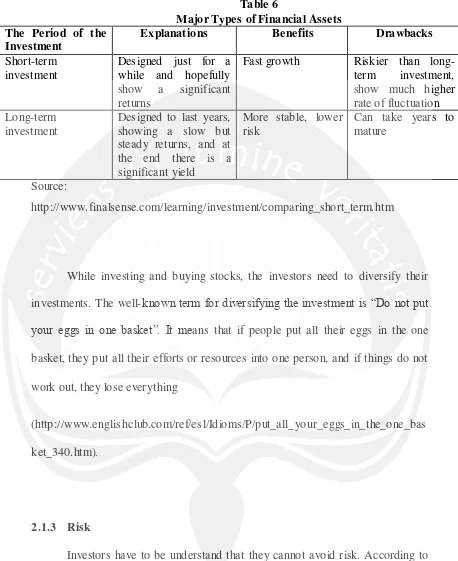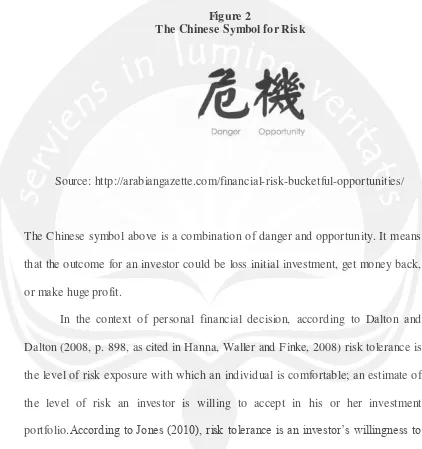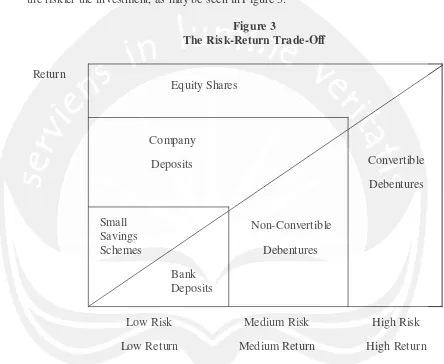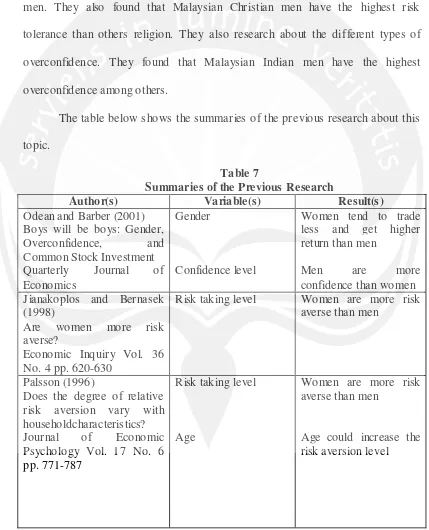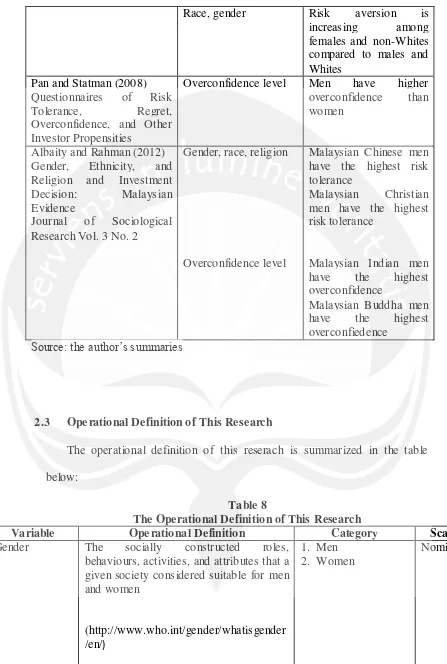10 CHAPTER II
THEORETICAL BACKGROUND AND PREVIOUS RESEARCH
2.1 Theoretical Background 2.1.1 Investors
Investor means an individual who does the investing activities with the
expectation of financial returns (http://www.investorwords.com/2630/). Barnewall (1987) divided two types of investor, passive and active investor. Table 3 provides
the characteristics of each group.
Table 3
Characteristics by Investor Type
Active Investors Passive Investors
Lifestyle Characteristics
Risk Taker Risk Avoider
Nonconformists (low dress consciousness)
Conformists (high dress consciousness)
Credit User Noncredit User
High Self-Confidence Low Self-Confidence Investment Orientation
Want Control of Invesment Noncontrol Oriented 70% in Higher Risks 70% in Lower Risk 30% in Lower Risks 30% in Higher Risk
Occupational Characteristics
Small Business Owner Corporate Executives Doctors-Surgeons Doctors-Nonsurgeons Dentists-Surgeons Dentists-Nonsurgeons
CPA-Independent CPA-Big Firm
Lawyer-Independent Lawyer-Large Firm Entrepreneurs
Source: Warren (1990)
11 There are three types of investors according to this site http://www.threetypes.com/philosophy/investor-types.shtml :
a. Savers or Risk Avoiders. Investors who are risk avoiders or savers are prefer to choose a comfortable retirement. They do not focus on their time on
investing or investment strategy; they either to entrust money managers or
financial planners to dictate their investments or they create “a diversified portfolio”. This type of investors seek low-risk growth of their capital, and
they are willing to accept a relatively low rate of return. Most of them are
investing for long-term financial security and retirement.
b. Speculators or Risk Taker. Unlike the previous type of investors, speculators
or risk taker choose to take control of their investment, and not rely solely on “time” to get to the point of financial independence.They are happy to let the
relatively low returns of a diversified portfolio go in order to try to achieve
the much higher returns of targeted investments. They are not scared to throw some money in order to get higher returns; they recognize that they can have higher returns than savers or risk avoiders, and are willing to do or try
anything to get those returns. They are always looking for the next great investment and more aggresive; for them, it is all about being in the right
place at the right time, and taking a chance on getting rich. If the investment
of today does not work out, there will always be another one tomorrow. c. Specialists. Like the second one, specialists realize tha t there is a more
12 right time”. They recognize that investing is no different than any other competitive endeavor – there will be winners and there will be losers, and the
winners will generally be those who are most prepared. They generally pick a
single investing area, and becomes an expert in that area. They know their investment area inside and outside, and instead of just entering and exiting investments, they have a plan. Having a plan is the key difference between speculators or risk takers and either savers or risk avoiders. The plan is the
plot for achieve investment success, and with it, they can achieve huge
returns with relatively low risk.
The benefit to be savers or risk avoiders is that they are free to spend their time and energy on things other than investing, but in return they will wait a long time
before they have the opportunity at financial freedom. Speculators or risk takers have the opportunity to “hit it big” if they end up at the right place at the right
time, but when they do not hit it big, they often do not even see as high of returns
as the savers or risk avoiders. While being specialists requires more times and efforts, the rewards are the most profound – both in terms of control over income
and the opportunity for financial success.
Differences in people‟s characteristics lead people has different strategy to
make an investment. According to the previous study by Bailard et al. (1986)
introduced five characteristics of investors, which are individualist; adventurer; guardian; celebrity; and straight arrow. Table 4 explains the differences of each
13 Table 4
Five characteristics of Investors
Types of Investors’ Characteristics Characters
Individualist Investors Avoid extreme volatility High desire
High confidence Do not want to rush Adventurer Investors Do the work alone
Do not need help from others Guardian Investors Very carefully in speculation
Less confidence
Prefer to choose a safe investment Celebrity Investors Like to follow fashion
Do not have any idea about investment
Straight Arrow Investors Balance between confidence and method of action
Source: Bailard et al. (1996)
2.1.2 Nature of Investment
The term investment meansevery asset that an investor owns or control, directly or indirectly, that has the characteristics of an investment, including such characteristics as the commitment of capital or other resources, the expectation of
gain or profit, or the assumption of risk (www.citizenstrade.org). The other
meaning of investment is that refers to the concept of deferred cons umption which may invlove purchasing an asset, giving a loan or keeping funds in a bank account
with the aim of generating future returns
(http://www.economywatch.com/investment/). According to Jones (2010), an investment can be defined as the commitment of funds to one or more assets that
14 There are various types of investments available. The various types of investment include (http://www.economywatch.com/investment/):
a. Cash investments. Cash investment include bank saving accounts, certificates
of deposit (CDs) and treasury bills. These type of investments generally pay a low rate of interest and are risky options in periods of inflation.
b. Debt securities. Debt securities provide returns in the fixed periodic payments and possible capital appreciation at maturity. These investments are safer and more „risk-free‟ investments tool than equities. Still, the returns
generally lower than other securities.
c. Stocks or equities. By buying stocks or equities, the investors could be a part-owner of the business and entitles them to a share of the profits generated by
the company. Stocks are more volatile and therefore riskier than bonds.
d. Mutual funds. It is a collection of stocks and bonds and involves paying a
professional manager to select spesific securities for the investors. The main
benefit of this investment is that the investors do not have to be involved in tracking in the investment.
e. Derivatives. Derivatives are financial contracts which are derived from the value of the underlying assets, such as equities, commodities and bonds, on
which they are based. Derivatives are used to minimize loss resulting from
fluctuations in the value of the underlying assets (hedging).
f. Commodities. The products that are traded on the commodities market are
typically agricultural and industrial commodities. These products need to be
15 g. Real estate. Real estate is the investments which involves a long-term commitment of funds and gains that are generated through rental or lease
income as well as capital appreciation. This investment includes investments
into residental or commercial properties.
These various types of investments options provide different risk-reward. These kinds of investment options can help the investors to create a portfolio that maximizes returns while minimizing risk exposure.
The investors have a choice to invest their funds directly or indirectly in
securities. Direct investing involves securities that investors not only buy and sell themselves but also have direct control over, whereas indirect investing refers to the buying and selling of the shares of investment companies which, in turn, hold
16 Direct Investing
Investors Figure 1
Direct versus Indirect Investing
Source: Jones, Charles (2010). Investments Principles and Concepts.Wiley. I vestor s retur is deter i ed y
Income
Capital gains and losses
Owns a
Portfolio of financial assets
Dividends and/or interest
17 Indirect Investing
I vestor s return is determined by
Income
Capital gains and losses
Capital gain or loss
which are
And generates Capital gain distributions
And the sale of Shares in the fund by the investor
Source: Jones, Charles (2010). Investments Principles and Concepts.Wiley.
The main difference is that the investment company stands between the investors
and portfolio of securities. Investor
owns shares in
Investment o pa y s fund
which is a
Portfolio of financial assets
Distributed to shareholders as which are
Distributed to shareholders as
Results in a
18 The table 5 below explains the major types of financial assets in direct and indirect investing.
Table 5
Major Types of Financial Assets DIRECT IN VESTING
Nonmarketable Saving deposits
Certificates of deposit
Money market deposit accounts U.S. saving bonds
Money market Treasury bills
Negotiable certificates of deposit Commercial paper
Eurodollars
Repurchase aggreements Banker‟s acceptances
Captal market Fixed income (treasures, agencies,
municipals, and corporates)
Equities (preferred stock and common stock)
Derivatives market Options
Future contract INDIRECT INVESTING
Investment companies Unit investment trust
Open end (money market mutual fund and stock, bond, and income funds) Closed end
Exchange-traded funds
Source: Jones, Charles (2010). Investments Principles and Concepts.Wiley.
Investors who invest directly in financial markets, whether using a broker or
others, have more varieties of assets from which to choose rather than investors
who invest indirectly in financial markets.
The period of the investment also could be different. There are two types
19 Table 6
Major Types of Financial Assets The Period of the
Investment
Explanations Benefits Drawbacks
Short-term investment
Designed just for a while and hopefully show a significant returns
Fast growth Riskier than long-term investment, show much higher rate of fluctuation Long-term
investment
Designed to last years, showing a slow but steady returns, and at the end there is a significant yield
More stable, lower risk
Can take years to mature
Source:
http://www.finalsense.com/learning/investment/comparing_short_term.htm
While investing and buying stocks, the investors need to diversify their
investments. The well-known term for diversifying the investment is “Do not put your eggs in one basket”. It means that if people put all their eggs in the one
basket, they put all their efforts or resources into one person, and if things do not
work out, they lose everything
(http://www.englishclub.com/ref/esl/Idioms/P/put_all_your_eggs_in_the_one_bas
ket_340.htm).
2.1.3 Risk
Investors have to be understand that they cannot avoid risk. According to Gibson (2003), risk is the chance of making a loss. Investors are rewarded for taking risks; in general, the higher the invesment risk, the higher is the reward or
20 Investors who prefer to play safe are said to be risk-averse and who like to take the risks are said to be risk-taker. Risk could be positive and negative
outcomes (http://pages.stern.nyu.edu/~adamodar/pdfiles/valrisk/ch1.pdf), and the
Chinese symbol can capture that statement. Figure 2
The Chinese Symbol for Risk
Source: http://arabiangazette.com/financial-risk-bucketful-opportunities/
The Chinese symbol above is a combination of danger and opportunity. It means
that the outcome for an investor could be loss initial investment, get money back,
or make huge profit.
In the context of personal financial decision, according to Dalton and
Dalton (2008, p. 898, as cited in Hanna, Waller and Finke, 2008) risk tolerance is the level of risk exposure with which an individual is comfortable; an estimate of
the level of risk an investor is willing to accept in his or her investment
portfolio.According to Jones (2010), risk tolerance is an investor‟s willingness to accept risk when investing. Risk tolerance is the inverse of risk aversion, a higher
21 2.1.4 Risk and Return
Return is the investors‟ motivation to force them in investment process. If
the investors invest their funds, they are taking a risk and hoping that they could
make an appreciable return. The higher the range of possible outcomes or return, the riskier the investment, as may be seen in Figure 3.
Figure 3
The Risk-Return Trade-Off
Return
Low Risk Low Return
Medium Risk Medium Return
High Risk High Return
Risk Equity Shares
Company Deposits
Non-Convertible Debentures Small
Savings Schemes
Bank Deposits
Convertible Debentures
22 According to Jones (2010), there are eight sources of risk that could be affect on the return. The sources of risk are:
a. Interest rate risk. It refers to the variability in a security‟s return resulting from changes in the level of interest rates. It could affect bonds more directly than common stocks, but it could affect both.
b. Market risk. It refers to the variability in returns resulting from fluctuations in the overall market – that is, the aggregate stock markert.
c. Inflation risk. Inflation causes money to decrease in value at some rate, and
does so whether the money is invested or not (www.investorwords.com). d. Business risk. It is the risk of doing business in a particular industry or
environment.
e. Financial risk. It is associated with the use of debt financing by companies. The higher the proportion of assets financed by debt (as opposed to equity),
the higher the variability in the returns.
f. Liquidity risk. It is the risk associated with the particular secondary market in which a security trades. The more uncertainty about the time of an investment
can be bought or sold and the price concession, the higher the liquidity risk. g. Currency risk (Exchange rate risk). The investors who invest only in his or
her country‟s stocks do not face the currency risk. The investors who invest in
such financial assets as international mutual funds, global mutual funds, closed-end single-country funds, foreign stocks, and foreign bonds are
23 h. Country risk. It is also called as political risk. With more investors which investing internationally, both directly and indirectly, the political, and
therefore economic, stability and viability of a country‟s economy need to be
considered.
A must to take a risk is an individual decision. Indeed, the higher risk people would take, the greater the returns or rewards.
2.1.5 Behavioral Finance
According to Agha et al. (2012), behavioral finance describes the behavior of investors and management in decision making; it illustrates the outcomes of interactions between investors and managers in financial and capital markets. It is
relatively new field that seeks to combine behavioral and cognitive psychological theory with conventional economics and finance to provide explanations for why
people make irrational financial decisions
(http://www.investopedia.com/university/behavioral_finance/). There are some key concepts of behavioral finance
(http://www.investopedia.com/university/behavioral_finance/behavioral4.asp): a. Anchoring. It is a condition when market participant makes financial
decision based on irrelevant figure or merely based on statistic, without
considering other factors such as fundamental situation.
b. Mental accounting. It is a behavior considers the way people treat money,
depends on how they get money, and consequently, it will affect the way they
24 c. Confirmation and hindsight bias. Confirmation bias could happen because people tend to seek the informations that support their idea rather than seek
out the information that contradicts. While hindsight bias could happen when
people believe that some past events were predictable and obvious, in fact, the event could not reassonably predicted.
d. Gambler’s fallacy.In this concept, people have tendency to believe that onset of certain random event is less likely to happen after the series of events. This
way of thingking is incorrect because past events do not change the
probability of some events that will occur in the future.
e. Herd behavior. It is a behavior when people will follow the act (rational or irrational) of larger group, however, individually can make different choice
with larger group.
f. Overconfidence. It is the tendency of people to overestimate his or her ability
in performing some tasks.
g. Overreaction and availability bias. People tend to overract against new information and create new opinion biased toward the latest news.
h. Prospect theory. This theory was represented by Kahneman and Tversky. It suggests that people value gain and loss in different way.
With this 8 key concepts of behavioral finance, people can identify some of the
25 2.1.6 Risk, Race, and Religion
Different in ethinicity in line with different in culture. Thus, it will affect
the people behavior such as perception about risk. Race has been shown to
influence risk perceptions (Flynn et al. 1994).
Javanese people has some rules and philosophy that different from other ethnicity. There are two concepts that relate with this topic. First, Narimo ing pandum, it is a concept that Javanese people believes God already gives them a
destiny and they could not reject it. While the second one is Urip ora ngoyo, it
represents that Javanese people would do activities without run over his or her power. For instance, he or she only has 1 million Rupiah for one month, so he or she should arrange the money well and spend wisely in order to not exceed the
limit. This two principles show that Javanese people seems to be risk averse. Compared Javanese and Chinese people, Chinese people has one principle
that called Zhi or Chi (www.sindoweekly- magz.com). Zhi or Chi means that
Chinese people has to work hard to achieve their dreams. They would be likely to take a risk, because they thought that they would receive more gains after they
take pains.
Then, talk about religion, by providing moral and ethical teachings for
their adherents to encourage them to behave in a specific way, religions might
directly influence individual economic behaviour by its impact on traits and attitudes (Barro and McCleary, 2003). The Bible and Qur‟an directly promotes
risk averse for individual financial decision.
26 in one place: „Divide your portion to seven, or even to eight, for you do not know
what misfortune may occur on the earth.‟ Furthermore, the Bible reminds against investing in assets which the investor does not exactly know: „Desire without
knowledge is not good, and whoever makes haste with his feet misses his way‟
(Proverbs 19:2). The Qur‟an tries to limit the riskiness of financial related
behaviour by avoiding gambling (Maisir) not only in the sense of games of chance, but also in the sense of investment in risky assets (Gharar) because it
considers as haraam. Muslims are also prohibited from engaging in Riba (addition
or increase or growth), interest as practiced by a majority of Islamic scholars to be equivalent to riba (http://www.kantakji.com/fiqh/Files/Economics/c129.pdf). „O you who believe, intoxicants, and gambling, and the altars of idols, and the games
of chance are abominations of the devil; you shall avoid them, that you may succeed‟ (Qur‟an 5:90). In short, both the Bible and the Qur‟an, how much
financial risk taking is allowed and in which assets adherents are permitted to
invest.
For Balinese people, there is term in Bali Language Bani Meli Bani
Ngadep, means that there is no ambition to get much money while doing an investment and/or a business activity
(http://sanggrahanusantara.blogspot.com/2009/03/). They believe that they could
be succeed to get high profits by making a n investment and/or business plan. For Hindu itself, there is Sad Ripu which comes from sad that means six and ripu that
means enemy (http://katahindu.wordpress.com/2012/06/18/sad-ripu-enam-
27 (http://katahindu.wordpress.com/2012/06/18/sad-ripu-enam- musuh-dalam-diri-manusia/):
a. Kama. Kama means negative desire.
b. Lobha. Lobha means greedy. People who are greedy is never satisfied.
c. Krodha. Krodha means angry. People who cannot control his or her temper would harm themselves and others.
d. Moha. Moha means confusion that can lead people‟s mind into the dark, so
people cannot think clearly. This will cause the person does not able to
distinguish which one is good and bad.
e. Mada. Mada means drunk. Drnk people‟s mind does not function properly. Consequently, he or she will be arrogant and say something that hurt other
people.
f. Matsarya. Matsarya means jealous. Matsarya people feel that he or she is
poor and has bad luck.
There are two components that indicates Hindus are more risk averse, Kama and
Lobha. If people could not control his or her desire and people who is greedy, he or she would invest more to meet his or her desire. This action would lead people
to take high-risk investment. In short, the Bible, Qur‟an and Weda propose how
much financial risk taking is allowed and in which assets adgerents are permitted
to invest.
In Buddha, there is Saddhā Bala means belief power
28 Bala will make them more confidence to do their activities, even the investment
activities. They also believe that Saddhā Bala can increase their potential to do
their activities. They stated if they want to be succeed, they have to develop
Saddhā Bala to increase their confidence level and their potential. If they could
not manage their confidence, they will be more and more confidence and then
become overconfidence. The overconfidence itself represents the characteristic of
risk taking behavior. If they cannot control their confidence, they can be a risk
taker in their daily activities, even in investment activities.
2.1.7 Gende r and Investment Perspective
There are different perspective between men and women investors to
respond risk and make investment decision. This stereotype may also have a biological basis. Gender refelcts psychological and social consideration as well as
biological factors. Barber and Odean (2001), in a large sample study of over
35,000 households, found that men trade 45% more than wo men and trading reduces men's net returns by 2.65 percentage points a year as compared to 1.72
percentage points for women.
Women investors tend to be more conservative than men when they
perceive a certain situation as ambigious (Zinkan and Karande, 1991). They
would be more likely to invest in money market mutual funds than male. While male would be more likely to invest in higher-risk investments, such as
high-growth stocks and global stocks, compared to women.
29 probability of gains and losses differently compared to men. While Schubert et al. (2000) found in the context of insurance against loss, research suggests that men and women‟s decision making is similar.
Weber et al. (2002) had a survey to quantify five distinct risk domains: financial risk, health and safety risk, recreational, ethical and social risks. The results explained that women were more risk averse in all domains except social risk.
Graham et al. (2002) suggested that gender differences in investment
strategies may be related to the differing styles of information processing. Men often did not process all the information since they are highly selective. In contrast, women are hypotherized and process informa tion comprehensively than
men.
2.1.8 Overconfidence
According to Cheng (2007) in Irwan Trinugroho‟s article about
“Overconfidence and Excessive Trading Behavior: An Experimental Study”,
overconfidence behavior is the most common characteristics found in humans that reflect one‟s tendency to overestimate the ability, the chances for success and the
probability that someone will gain positive outcomes and the accuracy of the
knowledge possessed.
There are four aspects of overconfidence in finance (Glaser and Weber,
2004), they are:
30 b. Better than average effect. It is the tendency to think that people has an
above average ability of skill.
c. Illusion of control. This is people‟s believe that he or she has more ability to
predict or more satisfactory results when they have high involvement in it. d. Unrealistic optimism. It is a form of defensive attribution wherein people
think that good things are more likely to happen to them than to others and that bad things are less likely to happen to them than to others
(http://www.psychology-
lexicon.com/cms/glossary/glossary-u/681-unrealistic-optimism.html).
These four aspects of overconfidence lead the invetors who are overconfidence trade more than the investors who do not overconfidence. According to Tversky
(1998), if each person has a limited amount of information and is confident that his or her predictions are right, the result is higher trading, much more than would
be expected under a rational model. If the investors are overconfidence and they
trade more in the markets, it seems that they will take more risk than the investors who do not overconfidence.
2.2 Previous Research
According to Barber and Odean (2001), women tend to trade less than men
and as a result they earn higher returns. However, men are more likely to invest in
riskier securities. The study found that men earn 1.4 percentage points less annually than women do on a risk-adjusted basis.
31 their reserach, they also found that women expected to accumulate less wealth on average, since lower risk is associated with lower returns on investment. This result in line with the study of “Does the Degree of Relative Risk Aversion Vary
with Household Characteristics?” by Palson (1996). He found that women tend to
be more risk averse than men. He also found that age is the only significant positive factor to increase risk aversion.
Manish and Vyas (2011) researched for gender differences in preferences
for risk and investment decision making. Psychologists suggest that women are
less confidence and are more methodical in their processing and accumulation style. The study founds that men engage in more risk taking and more overconfident than women. Women tend to put their funds in low risk – low
return investment.
According to Amos Tversky (1998), concluded three aspects that affect
investment decision making are risk attitudes, mental accounting, and
overconfidence. These three aspects provide directions to many market anomalies and investor phenomena. By understanding these biases may suggest ways to
improve investment strategies and performance in the market.
Hassan and Hussein (2006) identified factors influencing the UAE investor
behavior. They found six factors are the most influencing factors on the UAE
investor behavior: expected corporate earnings, get rich quick, stock marketability, past performance of the firm's stock, government holdings and the
creation of the organized financial markets. Other aspects are the least influencing
32 feeling on the economy. The unexpectedly least influence on the behavior of the UAE investor behavior that they found was religious reasons. In 2009, they
examined also the relationship between financial literacy and the influence of the
factors that affect the investment decision of the UAE individual investors who invest in the local financial markets. The study found the most influencing factor that affects the invesment decision is religious reason and the least affecting factor is rumors.
Renneboog and Spaenjers (2012) researched the effect of religious
affiliation on individual economic attitudes, such as thrift and risk, and investment behaviour in the Netherlands. The result was a positive relationship between individual religious affiliation and both risk aversion and individual propensity to
save.
The previous research by Barsky et al. (1997), they examined how risk
tolerance varies by individual demographic characteristics. They found risk
tolerance differs significantly by religion. The y stated that Chatholics are less risk averse than Protestants, whereas Jews are the most risk tolerant.
Riley and Chow (1992) examined asset allocation decision. They found risk aversion to be decrease with wealth, education, and age, until age 65, at
which time risk aversion increase. They also found risk aversion to be increase
among females and non-Whites compared to males and Whites.
Pan and Statman (2008) researched about “Questionnaires of Risk
Tolerance, Regret, Overconfidence, and Other Investor Propensities”. They found
33 Albaity and Rahman (2012) conducted a research about “Gender,
Ethnicity, and Religion and Investment Decisions: Malaysian Evidence. They
found that every gender, ethnicity, and religion have different investment
behavior. In their research, they found that Malaysian Chinese men have the highest risk tolerance compared to Malaysian Malay men and Malaysia n Indian men. They also found that Malaysian Christian men have the highest risk tolerance than others religion. They also research about the different types of
overconfidence. They found that Malaysian Indian men have the highest
overconfidence among others.
The table below shows the summaries of the previous research about this topic.
Table 7
Summaries of the Previous Research
Author(s) Variable(s) Result(s)
Odean and Barber (2001) Boys will be boys: Gender, Overconfidence, and Common Stock Investment Quarterly Journal of Economics
Gender
Confidence level
Women tend to trade less and get higher return than men
Men are more confidence than women Jianakoplos and Bernasek
(1998)
Are women more risk averse?
Economic Inquiry Vol. 36 No. 4 pp. 620-630
Risk taking level Women are more risk averse than men
Palsson (1996)
Does the degree of relative risk aversion vary with householdcharacteristics? Journal of Economic Psychology Vol. 17 No. 6 pp. 771-787
Risk taking level
Age
Women are more risk averse than men
34
Author(s) Variable(s) Result(s)
Manish and Vyas (2011) A Study of Psychological Reasons for Gender Differences in Preferences for Risk and Investment Decision Making
IUP Journal of Behavioral Finance Vol. 8 No. 3 pp. 45-60
Confidence level
Risk taking level
Women are less confidence
Women tend to put their funds in low risk – low return investment
Amos Tversky (1998)
The Psychology of Decision Making
Factors affecting investment decision
Risk attitudes, mental accounting, and overconfidence
Hassan and Hussein (2006) Factors Influencing Individual Investor Behavior: An Empirical study of the UAE Financial Markets
The Business Review, Cambridge Vol 5 No. 2 pp. 225-232
Factors affecting investment decision
Expected corporate earnings, get rich quick, stock marketability, past performance of the firm's stock, government holdings and the creation of the organized financial markets
Hassan and Hussein (2009) Financial literacy and investment decisions of UAE investors
The Journal of Risk Finance Vol. 10 No. 2 pp. 500-516
Factors affecting investment decision
Religious reason
Renneboog and Spaenjers (2012)
Religion, Economic Attitudes, and Household Finance
SSRN Working Paper Series
Religion There is a positive relationship between individual religious affiliation and both risk aversion and individual propensity to save Barsky et al. (1997)
Preference Parameters and Behavioral Heterogenity: An Experimental Approach in The Health and Retirement Study
The Quarterly Journal of Economics Vol. 112 No. 2 pp. 537-579
Religion Chatholics are less risk averse than Protestants, whereas Jews are the most risk tolerant
Riley and Chow (1992) Asset allocation and individual risk aversion Financial Analysts Journal Vol. 48 No. 6 pp. 32
35 Race, gender Risk aversion is increasing among females and non-Whites compared to males and Whites
Pan and Statman (2008) Questionnaires of Risk Tolerance, Regret, Overconfidence, and Other Investor Propensities
Overconfidence level Men have higher overconfidence than women
Albaity and Rahman (2012) Gender, Ethnicity, and Religion and Investment Decision: Malaysian Evidence
Journal of Sociological Research Vol. 3 No. 2
Gender, race, religion
Overconfidence level
Malaysian Chinese men have the highest risk tolerance
Malaysian Christian men have the highest risk tolerance
Malaysian Indian men have the highest overconfidence
Malaysian Buddha men have the highest overconfiedence
Source: the author‟s summaries
2.3 Ope rational Definition of This Research
The operational definition of this reserach is summarized in the table below:
Table 8
The Operational Definition of This Research
Variable Ope rational Definition Category Scale
36
Variable Ope rational Definition Category Scale
Ethnicity People‟s background that has value and/or culture differences among every ethnicity
1. Javanese 2. Chinese 3. Others
Nominal
Religion People‟s believe 1. Islam
2. Chatolic 3. Protestant 4. Hindu 5. Buddha
Nominal
Risk Taking Level
The wiilingness to take a risk 1. Conservative (14-23.99 points) 2. Moderate (24-33.99 points) 3. Aggresive (34-42 points) Interval Confidence Level
People overestimate their ability while performing their task
1. Less Confidence (15-26.99 points) 2. Confidence
(27-38.99 points) 3. Moderate person
(39-50.99 points) 4. Very Confidence
(51-6299 points) 5. Overconfidence
(63-75 points)
Interval
In this research, the author categorizes some categories such as gender,
ethnicity, religion, risk taking level, and confidence level. In the Bible, it is
already stated about gender. There is a verse in Genesis 1:26-27 stated Then God said, “Let us make man in our image, after our likeness. And let them have
dominion over the fish of the sea and over the birds of the heavens and over the
livestock and over all the earth and over every creeping thing that creeps on the earth.” So God created man in his own image, in the image of God he created
him; male and female he created them‟ (http://www.biblegateway.com/passage/).
37 For the ethnicity, the author uses Chinese, Javanese, and others. Others mean the other ethicities in Yogyakarta (table 1) are included in this research.
About Chinese itself, the author uses it because the Chinese economic
center is getting bigger (http://sejarah.kompasiana.com/2012/03/14/harmoni-kehidupan-cina-di-kota- gudeg-446942.html#). Now, the economic center is not only in Ketandan (Malioboro), but also around Poncowinatan and Gondokusuman. This figure below is the site map of pecinan (China Town) in
Yogyakarta.
Figure 4
The Site Map of Pecinan (China Town) in Yogyakarta
Source: http://pecinanjogja.blogspot.com/p/home.html
Because of the developing of the Chinese economic center, so the author uses
38 Based on table 2 about the distribution of the religion in Yogyakarta, the majority of the population are Muslim. The Muslim people in 2010 is about
90.48%. Followed by Chatolic, they are about 5.71% and Protestant 3.38%. Even
the population who are Hindu and Buddha lower than the three others, the authors considers all of the religions.
For risk taking level, there are three categories, which are conservative,
moderate, and aggresive. While confidence level has five categories, which are
less confidence, confidence, moderate, very confidence, and overconfidence. These categories both risk taking level and confidence level would be explained in
chapter 3.
2.4 Hypotheses
Previous researches shown that both demographic and psychographic
factors could affect the investment decision making whike taking a risk; which
demographic factors are age, earnings, education, gender, ethnicity, religion and employment (Zinkan and Karande, 1991; Graham et al., 2002; Schubert et al.,
2000; He et al., 2007; Odean and Barber, 2001; Riley and Chow, 1992; Flynn et
al., 1994; Albaity and Rahman, 2012; Hassan and Hussein, 2009; Renneboog and
Spaenjers, 2012, Barsky et al., 1997; Albaity and Rahman, 2012).
The hypothesis is formulated accordingly as follows:
39 According to the previous researches, overconfidence affect the invesment decision making, and the males Malaysian Buddha have highest overconfidence
than others (Tversky, 1998; Pan and Statman, 2008; Albaity and Rahman, 2012).
It represents that diversity among gender, ethnicity, and religion affect the different type of overconfidence. The hypothesis is formulated accordingly as follows:
H.2. Gender, ethnicity, and religion influence the individual investment
behavior, which is different type of confidence.
Some previous researches have shown that women and men have different investment perspective. This differences can be seen from three aspects that are risk averse, risk tolerance, and confidence level. According to previous
researches, men are risk taking, having high risk tolerance, and having high confidence level than women (Terrance Odean and Brad M. Barber, 2011; Hinz et
al., 1997, Byrnes et al., 1999, and Bernasek and Shwiff, 2011; Jianakoplos and
Bernasek, 1998 and Palsson, 1996; Rita, 2008; Manish and Vyas, 2011; Barber and Odean, 2001; Zinkan and Karande, 1991). The hypothesis is formulated
accordingly as follows:
40 Based on previous researches, it shown that there is different confidence level between men and women. The result stated that men are having high
confidence level than women (Odean and Barber, 2001; Manish and Vyas, 2011;
Tversky, 1998; Pan and Statman, 2008 ; Albaity and Rahman, 2008). The
hypothesis is formulated accordingly as follows:
